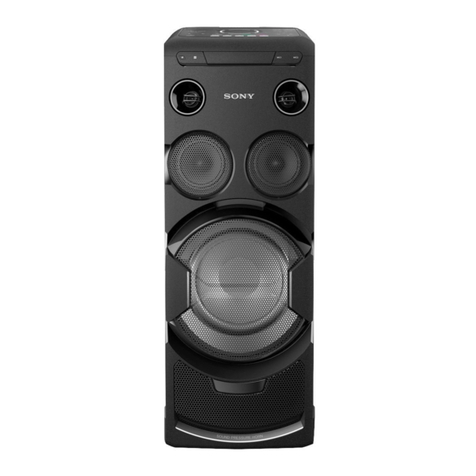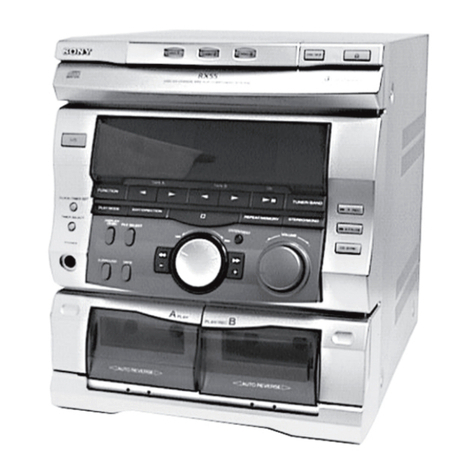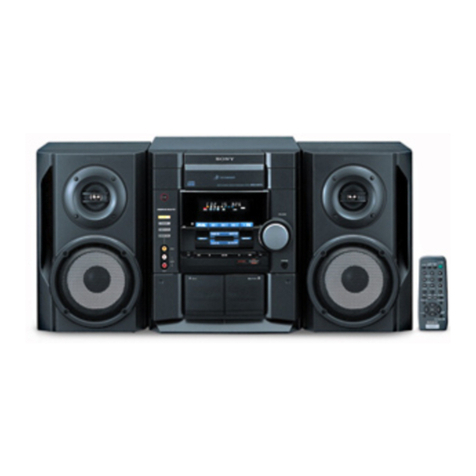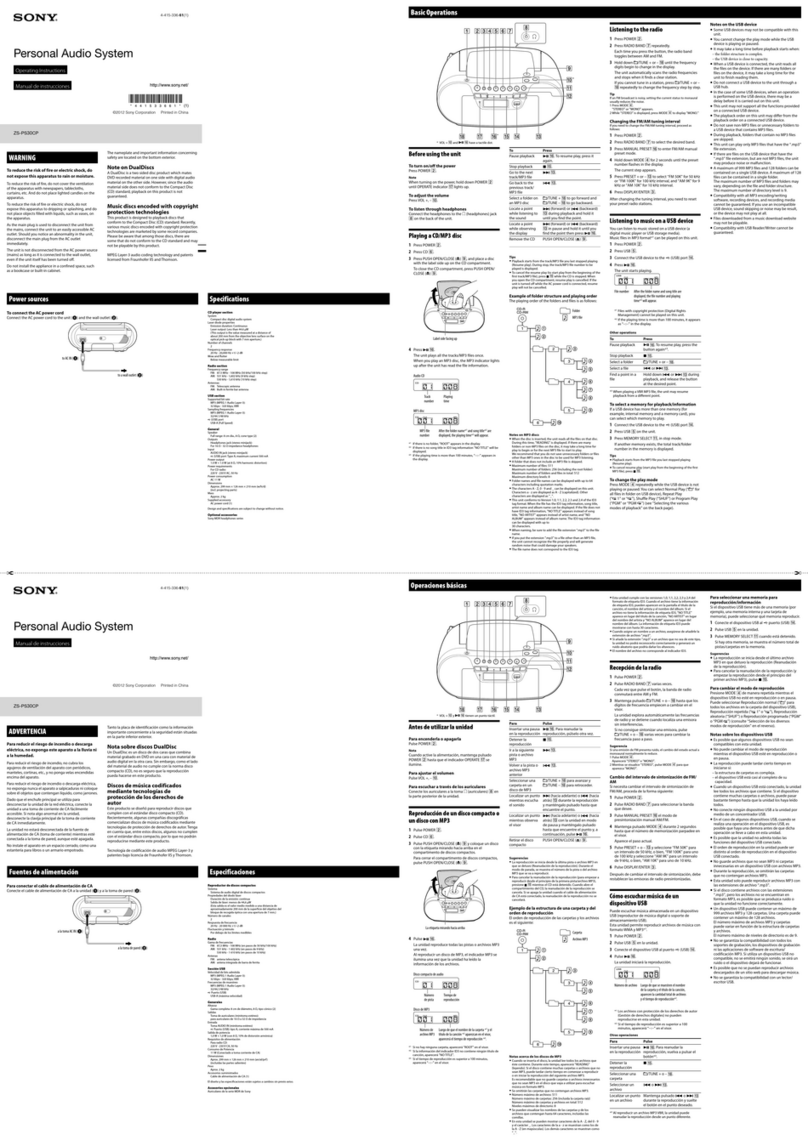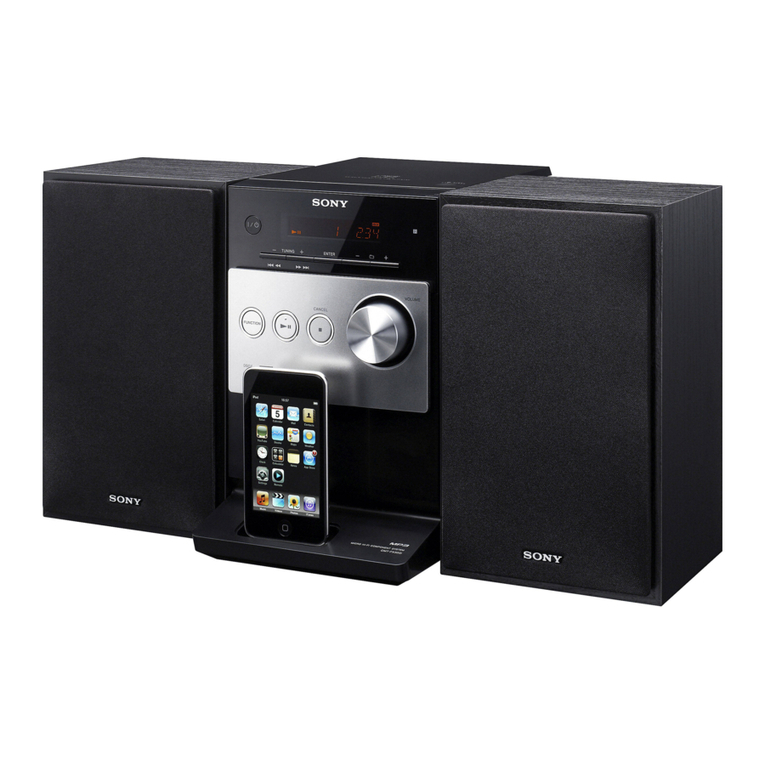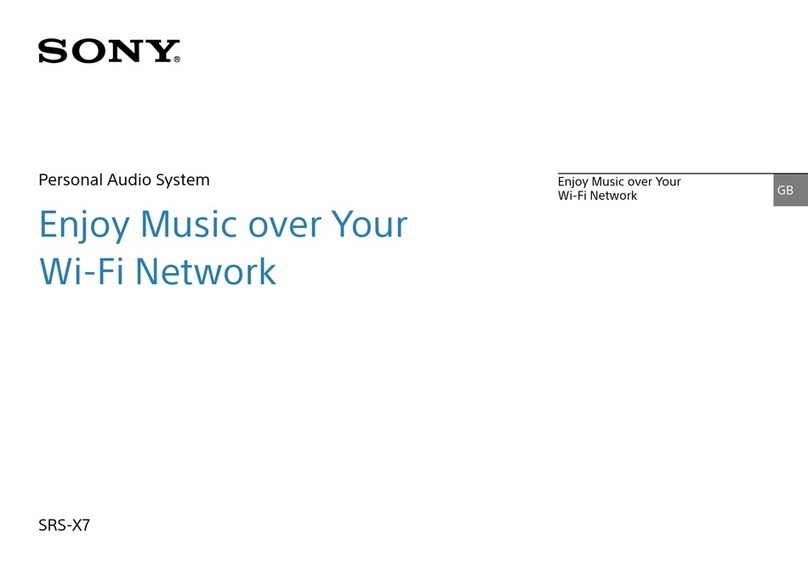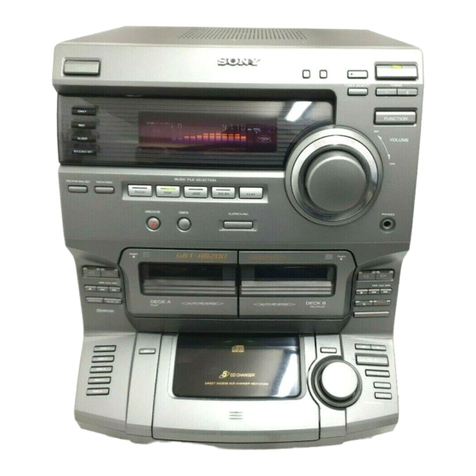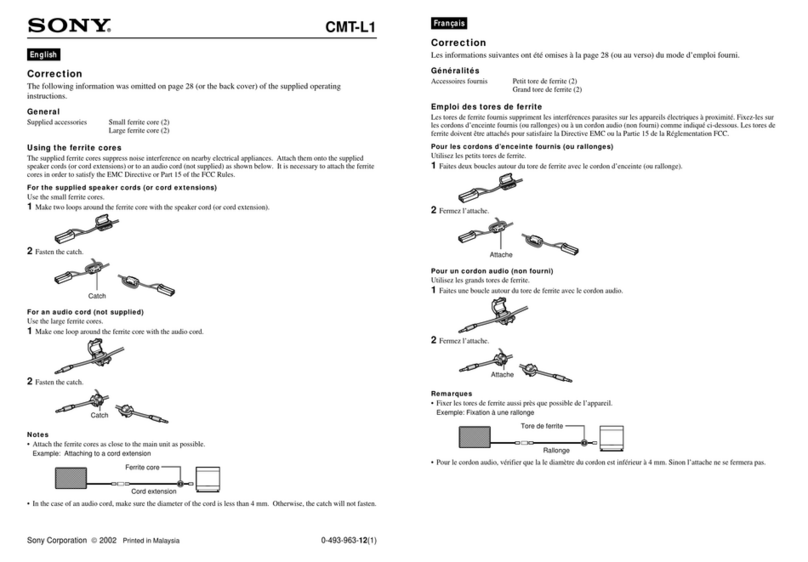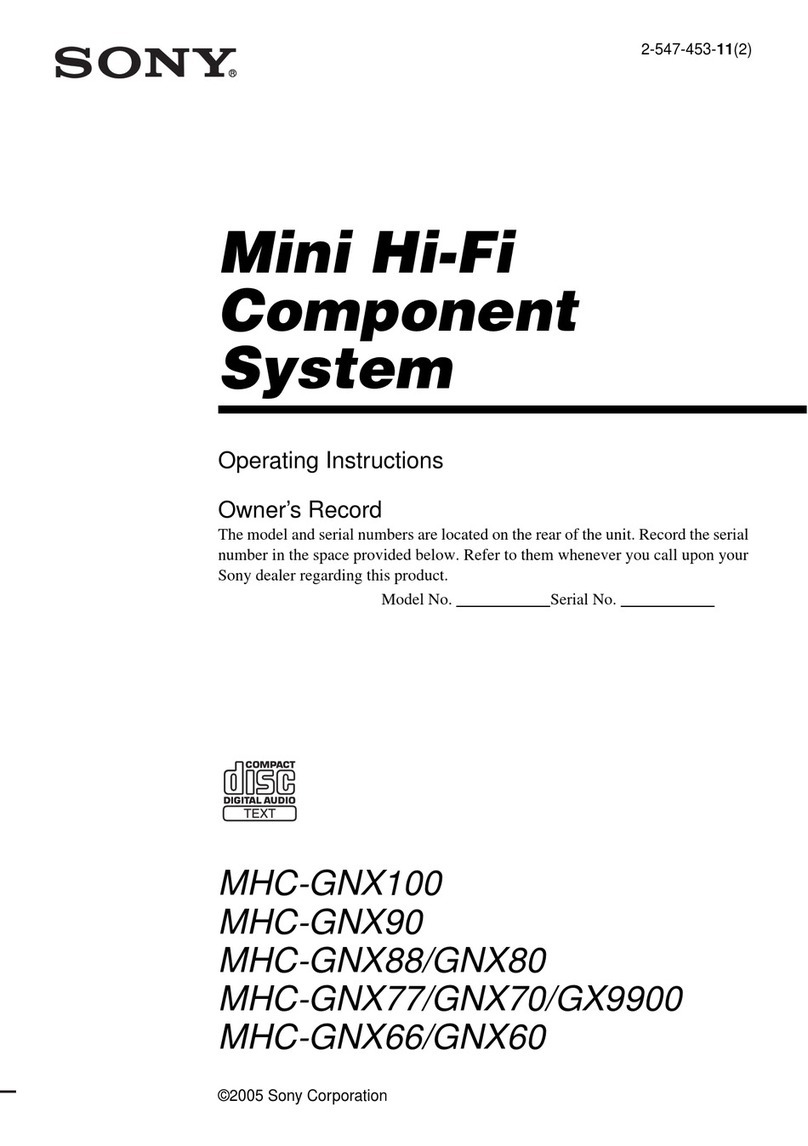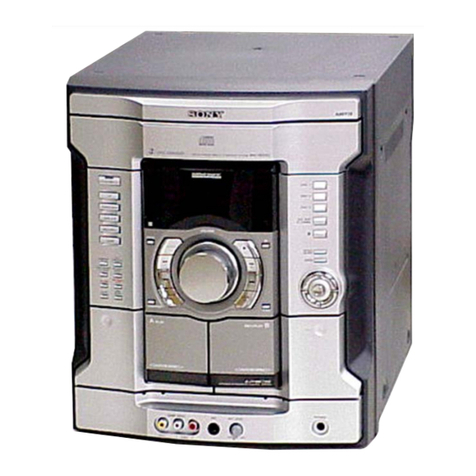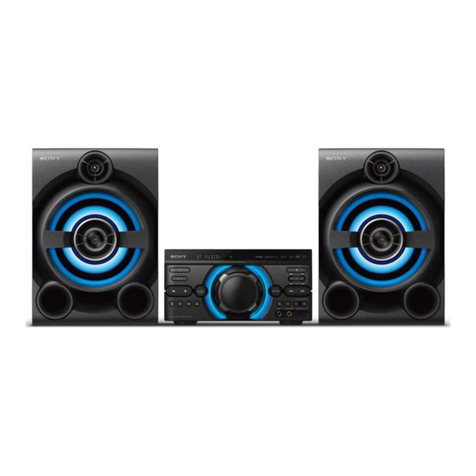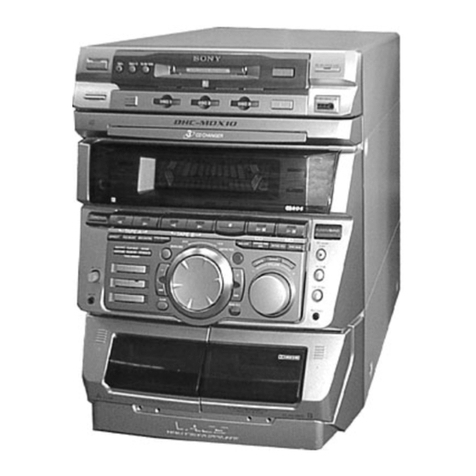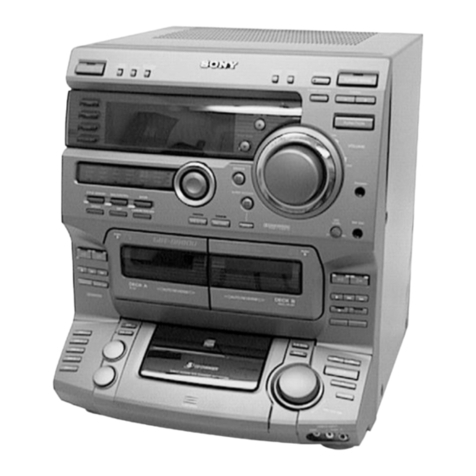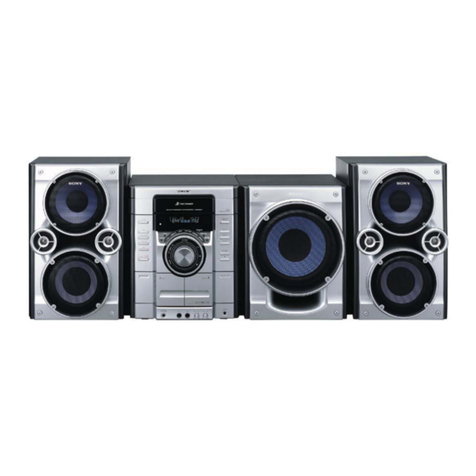
SERVICE MANUAL
Sony Corporation
Published by Sony Techno Create Corporation
SRS-X7
SPECIFICATIONS
PERSONAL AUDIO SYSTEM
9-893-945-03
2014C33-1
© 2014.03
US Model
Canadian Model
AEP Model
UK Model
Australian Model
Singapore Model
Korean Model
Ver. 1.2 2014.03
Note:
Be sure to keep your PC used for service and
checking of this unit always updated with the
latest version of your anti-virus software.
In case a virus affected unit was found during
service, contact your Service Headquarters.
CAUTION
Danger of explosion if battery is incorrectly replaced.
Replace only with the same or equivalent type.
Section for Speaker
Speakers
Full range speak er: Approx. 46 mm (1 7/8 inches) diameter × 2/
Subwoofer: Approx. 62 mm (2 3/8 inches) diameter × 1
Section for Amplier
POWER OUTPUT AND TOTAL HARMONIC DISTORTION:
Power Output (reference)
Using AC adaptor
Full range speak er: 8W+8W (at 1% harmonic distortion, 1 kHz,8 Ω)
Subwoofer: 16W (at 1% harmonic distortion,100 Hz, 4 Ω)
Using battery
Full range speak er: 3W+3W (at 1% harmonic distortion, 1 kHz, 8 Ω)
Subwoofer: 6W (at 1% harmonic distortion, 100 Hz, 4 Ω)
Section for Network
Compatible standards
IEEE 802.11 b/g (WEP 64 bit, WEP 128 bit, WPA/WP A2-PSK (AES), WPA/
WPA2-PSK (TKIP))
Radio frequency (US and Canadian models)
2.412 GHz – 2.462 GHz (2.4 GHz ISM Band, 11 Channels)/Channel 1
– Channel 11
Radio frequency (Except US and Canadian models)
2.412 GHz – 2.472 GHz (2.4 GHz ISM Band, 13 Channels)/Channel 1
– Channel 13
Section for BLUETOOTH
Output
BLUETOOTH Specication Power Class 2
Maximum communication range
Line of sight Approx. 10 m*1
Radio frequency
2.4 GHz band (2.4 000 GHz – 2.4835 GHz)
Communication System
BLUETOOTH Specication Version 3.0
Compatible BLUETOOTH Proles*2
A2DP (Advanced Audio Distribution Prole)/A VRCP (Audio Video
Remote Control Prole)
Supported codec*3
SBC (Subband Codec)*4/AA C*5/aptX
Transmission bandwidth (A2DP)
20 Hz – 20,000 Hz (with 44. 1 kHz sampling)
*1The actual range will vary depending on factors such as obstacles
between devices, magnetic elds ar ound a microwave oven, static
electricity, reception sensitivity, aerial’s performance, operating
system, software application, etc.
*2BLUETOOTH standard proles indicate the purpose of BLUET OOTH
communication between devic es.
*3Codec: Audio signal compression and conversion format
*4Subband Codec
*5Advanced Audio Coding
General
AUDIO IN
ANALOG Φ 3.5 mm ster eo mini jack
Network port
10BASE-T/ 100BASE-TX (Auto Polarity)
DC OUT
USB jack Type A (for charging the battery of a connected device) (5 V,
Max. 1.5 A: labeled on bottom of system)
Power (US, Canadian, AEP, UK and Singapore models)
DC 18V (using the supplied AC adaptor connected to AC 100V-240V,
50Hz/60Hz power supply) or, using built in lithium-ion battery
Power (Australian, Russian and Korean models)
DC 18V (using the supplied AC adaptor connected to AC 120V-240V,
50Hz/60Hz power supply) or, using built in lithium-ion battery
Usage life of lithium-ion battery (when the NETW ORK
OFF/ON switch is OFF)
Approx. 6 hours
Usage life of lithium-ion battery (when the NETW ORK
OFF/ON switch is ON)
Approx. 3 hours
Operating temperature
5 °C to 35 °C (41 °F to 95 °F)
Dimensions (w/h/d) (including pr ojecting parts and
controls)
Approx. 300 mm × 132 mm × 60 mm (11 7/8 inches × 5 2/8 inches ×
23/8 inches)
Mass
Approx. 1.9kg (4 lb 3 oz)
Supplied accessories:
AC power cord (1)/ AC adaptor (AC-E1826L) (US, Canadian, AEP, UK and
Singapore models) (1) / AC adaptor (AC-E1826) (Australian, Russian and
Korean models) (1)/ Start Guide “Enjoy Music over Your Wi-Fi Network”/
Reference Guide, warranty card (US model) / Reference Guide (Except US
model) / Warranty card (Except Singapore model)
Design and specications are subject to change without notice.
On Copyrights
SONY, Sony Entertainment Network and the logos ar e trademarks
of Sony Corporation.
Windows, the Windows logo , and Windows Media ar e either
registered trademarks or trademarks of Micr osoft Corporation in
the United States and/or other c ountries.
This product is protected by certain intellectual property rights of
Microsoft Corporation. Use or distribution of such technology
outside of this product is prohibited without a license from
Microsoft or an authorized Microsoft subsidiar y.
Pandora, the Pandora logo, and the Pandora trade dress are
trademarks or r egistered trademarks of P andora Media, Inc., used
with permission.
Spotify and Spotify logos are trademarks of the Spotify Gr oup.
Apple, the Apple logo, AirPlay, iPad, iPhone, iPod, iPod nano, iPod
touch, iTunes, Mac, and OS X are trademarks of Apple Inc.,
registered in the U.S. and other countries. App Store is a ser vice
mark of Apple Inc.
“Made f or iPod,” “Made f or iPhone,” and “Made for iPad” mean that
an electronic accessory has been designed to c onnect specically
to iPod, iPhone, or iPad, respectively, and has been certied by the
developer to meet Apple perf ormance standar ds. Apple is not
responsible for the operation of this device or its compliance with
safety and regulatory standards. Please note that the use of this
accessory with iPod, iPhone, or iPad may a ect wireless
performance.
Macintosh and Mac OS ar e trademarks of Apple Inc., registered in
the U.S. and other countries.
“” is a mark of the Wi-Fi Allianc e.
Wi-Fi®, Wi-Fi Protected Access® and Wi-Fi Allianc e® are registered
marks of the Wi-Fi Allianc e.
Wi-Fi CERTIFIED™, WPA™ , WPA2™ and Wi-Fi Protected Setup™ ar e
marks of the Wi-Fi Allianc e.
DLNA™, the DLNA Logo and DLNA CERTIFIED™ ar e trademarks,
service marks, or certication marks of the Digital Living Network
Alliance.
© 2013 CSR plc and its group companies.
The aptX® mark and the aptX logo ar e trade marks of CSR plc or
one of its group companies and may be r egistered in one or mor e
jurisdictions.
“S-Master” is a trademark of Sony C orporation.
ClearAudio+ and are trademarks of Sony
Corporation.
“DSEE” and are trademarks of Sony C orporation.
MPEG Layer-3 audio coding technology and patents licensed from
Fraunhofer IIS and Thomson.
The BLUETOOTH® word mark and logos ar e owned by the
Bluetooth SIG, Inc. and any use of such marks by Sony C orporation
is under license. Other trademarks and tr ade names ar e those of
their respective owners.
The N Mark is a trademark or r egistered trademark of NFC Forum,
Inc. in the United States and in other countries.
Google Play and Andr oid are trademarks of Google Inc.
“Xperia” and “Xperia Tablet” are trademarks of Sony Mobile
Communications AB.
WALKMAN® and W ALKMAN® logo are registered trademarks of
Sony Corporation.
The system names and pr oduct names indicated in this manual ar e
generally the trademarks or registered trademarks of the
manufacturer.
™ and ® marks ar e omitted in this manual.

